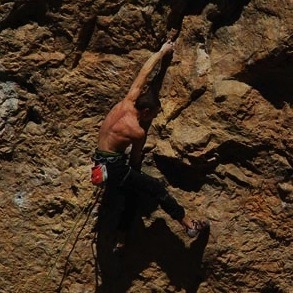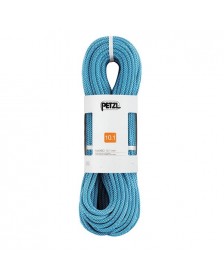
Climbing ropes are dynamic ropes. If you need ropes for rappelling, ziplines ect. you need to use static ropes. We are happy to help.

Climbing rope for sport climbing and trad climbing
Climbing ropes are available in many different versions and editions on this page. Which climbing rope to choose depends on what it will be used for. We have ropes with and without impregnation for outdoor and indoor use, respectively, and we have climbing ropes in a number of different diameters. Climbing rope is available by the metres.
We carry various brands of climbing ropes and are constantly looking for the best products for you.
Rope types
Single rope
These are best for traditional climbing, sports climbing, big-wall climbing and top rope.
The vast majority of climbers buy single ropes. The name “single” indicates that the rope is designed to be used alone and not with another rope, as some other rope types are.
Single ropes come in many different diameters and lengths, making them suitable for a wide range of climbing disciplines, and they are generally easier to handle than twin-rope systems.
Some single ropes are also classified as half ropes and double ropes, so you can use them with one of the three climbing techniques. It is important to use only a rope as it was designed and tested for.
Single rope is marked with a one in a circle at each end of the rope.
Half rope
These are best for traditional climbing on indirect multi-pitch routes, mountaineering and ice climbing.
When climbing with half ropes, use two ropes. As you ascend, secure with one rope for securing on the left and the other for securing on the right. When done correctly, this allows the ropes to run parallel and straight, reducing rope pulls on indirect routes.
Half rope is designed and tested only for use as matching pair; do not mix sizes or brands.
Half rope has a ½ symbol in a circle at each end.
Twin rope
These are best for traditional climbing on direct multi-pitch routes, mountaineering and ice climbing.
Similar to half-ropes, twin ropes are a two-rope system. But with twin ropes, you should ALWAYS have both ropes through each safety device, just as you would with a single rope. This means that there will be more rope pulls than with half ropes, which makes twin ropes a good option for direct routes. On the plus side, twin ropes tend to be slightly thinner than half ropes, making it a lighter and less bulky system.
Twin rope has an infinite symbol (∞) in a circle at each end.
Dynamic climbing rope
The fact that a climbing rope is dynamic means that it can elongation about 10% of its length. Due to this elasticity, you always climb on dynamic ropes, because it gives a softer braking when you fall. Dynamic climbing rope is available both with and without water-repellent impregnation for outdoor and indoor climbing, respectively.
Static climbing rope
Static rope has no elastic properties. It does not extend and can therefore only be used for abseiling / rappelling, where there is no danger of falling. It is also suitable for establishing smaller ziplines or other rope facilities. Static rope must NEVER be used for climbing where there is a risk of falling. The fact that the rope is static means that all the force that arises in connection with a fall is NOT absorbed by the climbing rope, but that the body is instead exposed to the entire force in at once.
Diameter and length
Diameter
Single ropes up to 9.4 mm: ropes in this range are very light, making them ideal for long multi-pitch routes where weight is important. However, thin single ropes are not classified to have as many falls as thicker ropes, they are harder to handle, and they tend to be less durable.
9.5 - 9.9 mm single rope: A single rope in this range is good for all-round use, including traditional and sports climbing. These ropes are light enough to take in the mountains, yet durable enough for top ropes at the local cliff. They are generally more durable than very thin ropes and they are easier to handle.
Single ropes 10 mm and above: ropes with a diameter of 10 mm and above are best for gym climbing, frequent top ropes, figuring out movements on sports routes and big-wall climbing. These climbing styles can wear a rope faster, so it is wise to go with a thicker, more durable rope.
Half rope and twin rope: Half rope typically has a diameter of approx. 8 - 9 mm, while twin rope are usually approx. 7 - 8mm thick.
Static ropes: Static ropes have a diameter of 9 - 13 mm so you can find exactly the diameter you need.
Length
Dynamic ropes for climbing are available from 30 to 80 m in length. A 60 m rope is the standard and will meet your needs most of the time.
Outdoor Climbing Rope: When deciding which length to buy, keep in mind that your rope should be so long that half its length is equal to or greater than the route you need to climb.
For example, if a climbing route is 30 m long, you will need at least a 60 m rope to be able to climb up and get down again from an anchor at the top of the route. Some modern sport climbing routes require a 70 m rope to lower to the ground.
Indoor climbing rope: Shorter length rope, approx. 35 m long, often used for gym climbing, because indoor routes tend to be shorter than outdoor routes. Again, make sure the length of the rope is long enough to lower a climber.
Static ropes: Static ropes for rescue work, caving, climbing of fixed lines come in different lengths and are often sold by the metre so you can get the exact length you need.
Features and details
Center mark: Most ropes have a center mark, often black dye, to help you identify the center of the rope. Being able to identify the center of your rope is important when rappelling.
Two-coloured: Some ropes are two-coloured, which means that they have a change in weave pattern that clearly separates the two halves of the rope and creates a permanent, easy-to-identify center mark. This is a more effective (and often more expensive) way to mark the center of a rope than black dye because dye can fade and become difficult to see.
End Warning Marks: Some ropes include thread or black dye indicating that you are reaching the end of the rope. This is useful when rappelling or lowering a climber.
Security
UIAA falls
The UIAA (Union Internationale des Associations d'Alpinisme) tests ropes to see how many falls they can withstand before they break. Laboratory falls create much greater force than most real-world climbing falls. Therefore, the fall assessment is mostly a comparative value.
All ropes that meet the UIAA's fall assessment standard are safe to climb with. A rope with a higher fall rating may mean that that rope will last longer than a rope with a lower rating. However, always check your rope carefully after a hard fall and consider discarding it if damage is detected.
Static elongation
Static elongation, also called working elongation, is the amount that a dynamic rope extends with a weight of 80 kg hanging from it. Elongation on single and double ropes must not exceed 10 percent of the total rope length and half ropes must not exceed 12 percent.
Static extension is important to consider when climbing top-rope or pulling equipment. Higher static elongation generally indicates less efficiency because energy is wasted through rope stretching.
Dynamic elongation
Dynamic elongation is the distance that the rope extends during the first UIAA fall. Higher elongation equals a longer fall, so in general a lower number is better because smaller stretch can prevent a falling climber from hitting a ledge or ground. However, less dynamic elongation means a harder catch off the climbers, belayer and gear. The UIAA requires that ropes do not extend more than 40 percent of the length of the entire rope.
Impact force
Impact force is the amount of force in kilotons applied to the falling weight during the first UIAA fall. A lower number indicates less force on the falling climber, belayer and gear. The higher the dynamic elongation, the lower the impact force.
Lower impact force ensure a soft landing on the rope when you fall, but with it usually comes longer elongation, which can be less effective when climbing top-ropes.
Prusik cord
Prusik cord is a strong, thin and static nylon rope. We have prusik cord from 2 to 7 mm.prusik cord is typically used in connection with abseiling, where theprusik cord is tied around the climbing rope and acts as a safety device for the abseiler. As a rule of thumb, you should choose aprusik cord with a diameter that is half the diameter of your climbing rope. Prusik cord of 5 to 7 mm is the most common.
If you are in doubt about which climbing rope to choose, we would love to hear from you

















